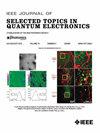Open Cavity Anti-Resonant Reflecting Waveguide for Simultaneous Measurement of Salinity and Temperature
IF 5.1
2区 工程技术
Q1 ENGINEERING, ELECTRICAL & ELECTRONIC
IEEE Journal of Selected Topics in Quantum Electronics
Pub Date : 2025-09-12
DOI:10.1109/JSTQE.2025.3609729
引用次数: 0
Abstract
An open cavity anti-resonant reflecting waveguide is proposed and experimentally demonstrated for simultaneous measurement of salinity and temperature. Femtosecond laser micromachining is used to introduce a pair of open channels on a hollow core fiber (HCF) based anti-resonant reflecting waveguide. Results indicate that the anti-resonant reflecting guiding mechanism still exists even when large rectangular channels are introduced to the cavity wall. The strength of the anti-resonant reflecting effect is influenced by the geometric size of the rectangular channels. Sea water salinity measurement is realized with such a device. The intensity at the resonant wavelength increases with increasing salinity, exhibiting a sensitivity of 2.05 dB/% within a 2%-7% saline concentration range, while the transmission Dips shift toward shorter wavelength with a sensitivity of -0.84 nm/%. The temperature sensitivity is 0.049 nm/°C across a temperature range of 30°C-80°C. By tracing the wavelength change of two transmission Dips, the salinity and temperature can be determined simultaneously. The proposed device has advantages such as simple structure and fast response, which has promising applications in marine environmental science and medical biology.同时测量盐度和温度的开腔抗谐振反射波导
提出了一种同时测量盐度和温度的开腔抗谐振反射波导,并进行了实验验证。利用飞秒激光微加工技术在空心光纤抗谐振反射波导上引入了一对开放通道。结果表明,即使在腔壁上引入大的矩形通道,反谐振反射引导机制仍然存在。反谐振反射效应的强度受矩形通道几何尺寸的影响。用该装置实现了海水盐度的测量。共振波长处的强度随盐度的增加而增加,在2% ~ 7%的盐度范围内灵敏度为2.05 dB/%,而透射倾角向更短的波长移动,灵敏度为-0.84 nm/%。温度灵敏度为0.049 nm/°C,温度范围为30°C-80°C。通过跟踪两个透射倾角的波长变化,可以同时确定盐度和温度。该装置具有结构简单、响应速度快等优点,在海洋环境科学和医学生物学等领域具有广阔的应用前景。
本文章由计算机程序翻译,如有差异,请以英文原文为准。
求助全文
约1分钟内获得全文
求助全文
来源期刊

IEEE Journal of Selected Topics in Quantum Electronics
工程技术-工程:电子与电气
CiteScore
10.60
自引率
2.00%
发文量
212
审稿时长
3 months
期刊介绍:
Papers published in the IEEE Journal of Selected Topics in Quantum Electronics fall within the broad field of science and technology of quantum electronics of a device, subsystem, or system-oriented nature. Each issue is devoted to a specific topic within this broad spectrum. Announcements of the topical areas planned for future issues, along with deadlines for receipt of manuscripts, are published in this Journal and in the IEEE Journal of Quantum Electronics. Generally, the scope of manuscripts appropriate to this Journal is the same as that for the IEEE Journal of Quantum Electronics. Manuscripts are published that report original theoretical and/or experimental research results that advance the scientific and technological base of quantum electronics devices, systems, or applications. The Journal is dedicated toward publishing research results that advance the state of the art or add to the understanding of the generation, amplification, modulation, detection, waveguiding, or propagation characteristics of coherent electromagnetic radiation having sub-millimeter and shorter wavelengths. In order to be suitable for publication in this Journal, the content of manuscripts concerned with subject-related research must have a potential impact on advancing the technological base of quantum electronic devices, systems, and/or applications. Potential authors of subject-related research have the responsibility of pointing out this potential impact. System-oriented manuscripts must be concerned with systems that perform a function previously unavailable or that outperform previously established systems that did not use quantum electronic components or concepts. Tutorial and review papers are by invitation only.
 求助内容:
求助内容: 应助结果提醒方式:
应助结果提醒方式:


